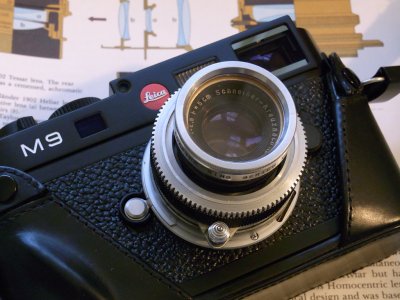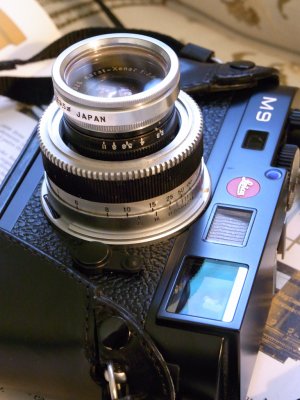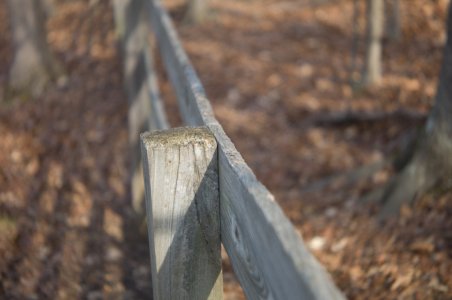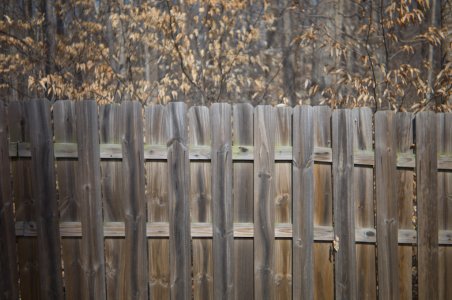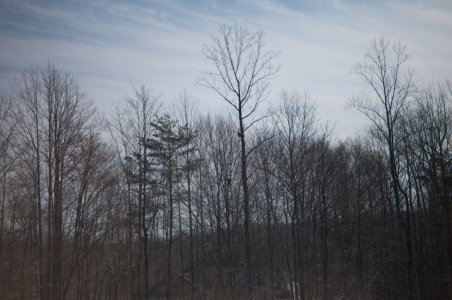phofseth
Established
a recent book "Neue legenden und geschicten aus der photoindustrie" by Hartmut Thiele contains transcripts of original negotiations between Kodak and Zeiss on using the 50mm Sonnar 1,5 in a Retina camera. Designs were more or less ready, but discussions on exact focal length plus worries at Zeiss about competition with Contax delayed matters, so it never left the drawing board. (The book also contains material on the relations between the Rollei factory and Zeiss Jena where uneven T-coatings and late deliveries were a problem + lots of other documentation.
Mr. Thiele is a very knowledgeable and reliable source, and his books on Leitz, Angenieux, and Zeiss serial numbers are well regarded.
p.
Mr. Thiele is a very knowledgeable and reliable source, and his books on Leitz, Angenieux, and Zeiss serial numbers are well regarded.
p.
Very interesting.
I have one fixed-lens camera with between lens shutter with a Sonnar formula lens: a Walz 35 with classic 7/3 4.8cm F1.9 Sonnar. Next time I have a parts Retina II out- will check if it has the diameter required for an F1.5 Sonnar.
I have one fixed-lens camera with between lens shutter with a Sonnar formula lens: a Walz 35 with classic 7/3 4.8cm F1.9 Sonnar. Next time I have a parts Retina II out- will check if it has the diameter required for an F1.5 Sonnar.
phofseth
Established
not only diameter problems
not only diameter problems
The Retina Sonnar project stranded not only for business reasons, but Kodak had measured and planned for a focal length of 51 to 51,5mm while the Sonnar was in fact longer so the lens would have to be recalculated.
Dr Bertele, the creator of the Sonnar stated that he had calculated a 1,4 Sonnar which could be produced, He stated that the Biotar 50/1,4 was better but with a lower T-stop than the present Sonnar, but Kodak did not want the Biotar.
The Sonnar that Kodak would use apparently had the same dimensions as the Contax version. Mr Thiele is quite exact ad focal lengths, but the original post-war negotiations document he quotes apparently did not have the dimensional data.
p.
not only diameter problems
The Retina Sonnar project stranded not only for business reasons, but Kodak had measured and planned for a focal length of 51 to 51,5mm while the Sonnar was in fact longer so the lens would have to be recalculated.
Dr Bertele, the creator of the Sonnar stated that he had calculated a 1,4 Sonnar which could be produced, He stated that the Biotar 50/1,4 was better but with a lower T-stop than the present Sonnar, but Kodak did not want the Biotar.
The Sonnar that Kodak would use apparently had the same dimensions as the Contax version. Mr Thiele is quite exact ad focal lengths, but the original post-war negotiations document he quotes apparently did not have the dimensional data.
p.
The focal length issue is interesting, the wartime 5cm F1.5 produced in Leica mount have a focal length close enough to the Leica 51.6mm standard that focus is maintained across the full range at F1.5. This is not true of most Contax mount Sonnars mounted in the same focus mount. The focal length of a standard Sonnar can be lowered by reducing the spacing between the front and rear groups. Between 1~2mm is usually required.
In the new book: is there information about the wartime Sonnars produced in Leica Mount? The question is: was the Sonnar 5cm F1.5 recomputed for 51.6mm focal length, or was the separation between the lens groups changed to achieve better focus?
Kodak could have easily modified the RF of the Retina II for a 52.4mm lens. The early post-war Retina II featured a 47mm F2 Ektar, others have the 50mm F2 Xenon. The focal length deviation of the Sonnar was about +/-1%, meaning a nominal 52.4mm meant producing lenses from 51.9mm to 52.9mm. I have "Cherry-Picked" 5 pre-war 5cm F1.5 Sonnars that can be used wide-open across the full-range on a Leica, converted to Leica mount using a Jupiter-3 focus mount.
https://www.lindemanns.de/shop/foto...en-und-geschichten-aus-der-photoindustrie.php
Text is in German.
In the new book: is there information about the wartime Sonnars produced in Leica Mount? The question is: was the Sonnar 5cm F1.5 recomputed for 51.6mm focal length, or was the separation between the lens groups changed to achieve better focus?
Kodak could have easily modified the RF of the Retina II for a 52.4mm lens. The early post-war Retina II featured a 47mm F2 Ektar, others have the 50mm F2 Xenon. The focal length deviation of the Sonnar was about +/-1%, meaning a nominal 52.4mm meant producing lenses from 51.9mm to 52.9mm. I have "Cherry-Picked" 5 pre-war 5cm F1.5 Sonnars that can be used wide-open across the full-range on a Leica, converted to Leica mount using a Jupiter-3 focus mount.
https://www.lindemanns.de/shop/foto...en-und-geschichten-aus-der-photoindustrie.php
Text is in German.
phofseth
Established
yes German books and netsites are usually in German. Google translate helps for netsites, not for books.
Correction; the Sonnar redesigner quoted in the book is Merté; Bertele left Zeiss long before the 1,4 was considered.
p,
Correction; the Sonnar redesigner quoted in the book is Merté; Bertele left Zeiss long before the 1,4 was considered.
p,
If the book were available in electronic format, I'd get it and use an auto-translation program to read it.
Gregm61
Well-known
(The book also contains material on the relations between the Rollei factory and Zeiss Jena where uneven T-coatings and late deliveries were a problem + lots of other documentation.
p.
Possibly one of the reasons why Rollei developed the additional relationship with Schneider for the Xenar and later Xenotar.
phofseth
Established
schneider switch
schneider switch
exactly this is mentioned in the transcripts from the Zeiss archives that he reproduces.
p.
schneider switch
exactly this is mentioned in the transcripts from the Zeiss archives that he reproduces.
p.
I remember reading the issue with Zeiss supplying lenses to Rollei- long ago, the statement was that 2 in 3 Zeiss lenses did not meet requirements.
phofseth
Established
The faults that Franke&Heidecke complained about was coatings which did not cover the whole lens element , apparently due to the production method. and regarded as trivial by Zeiss Jena since covered by the mount. Possibly sold to another camera producer.
The info above ad adjusting focal length is not discussed in the book, but Merthés arguments ad redesign are briefly quoted.
p.
The info above ad adjusting focal length is not discussed in the book, but Merthés arguments ad redesign are briefly quoted.
p.
phofseth
Established
The sonnar was apparently recomputed as 40mm for the Zeiss Tenax right before the war caused an end to peacetime production.
p.
p.
TenEleven
Well-known
I just want to add that both the Schneider (and rarer) Rodenstock Heligon "50mm" lenses are indeed a nominal FL of around 45-47mm. This is true for the earlier (Retina II) and later (Retina IIC) versions I tried.The focal length issue is interesting, the wartime 5cm F1.5 produced in Leica mount have a focal length close enough to the Leica 51.6mm standard that focus is maintained across the full range at F1.5. This is not true of most Contax mount Sonnars mounted in the same focus mount. The focal length of a standard Sonnar can be lowered by reducing the spacing between the front and rear groups. Between 1~2mm is usually required.
In the new book: is there information about the wartime Sonnars produced in Leica Mount? The question is: was the Sonnar 5cm F1.5 recomputed for 51.6mm focal length, or was the separation between the lens groups changed to achieve better focus?
Kodak could have easily modified the RF of the Retina II for a 52.4mm lens. The early post-war Retina II featured a 47mm F2 Ektar, others have the 50mm F2 Xenon. The focal length deviation of the Sonnar was about +/-1%, meaning a nominal 52.4mm meant producing lenses from 51.9mm to 52.9mm. I have "Cherry-Picked" 5 pre-war 5cm F1.5 Sonnars that can be used wide-open across the full-range on a Leica, converted to Leica mount using a Jupiter-3 focus mount.
Hartmut Thiele, Neue Legenden und Geschichten aus der Photoindustrie, 25 Berichte und Geschichten., Kamerageschichte : Kam.-Geschichte allg., , Lindemanns Buchhandlung
Text is in German.
I know this for a fact because this turned out to be a huge curve ball for my plans to do a LTM conversation of the Xenon/Heligon using an old I22 as base. I had done the "top section" including sourcing a fitting aperture, but after setting infinity I found that the RF absolutely did not track with massive amounts of front-focus. (FL actual << FL RF)
In the end instead of being able to use them as-is or perhaps sanding the RF cam a bit - I had to go ask a machine shop for assistance...
I always thought it odd that the Ektar for the postwar Retina II is marked 47mm, but the Xenon for the Retina II is 50mm. Figured one was mismarked, rather than the camera changing the RF mechanism. The Karat Xenar (5 element) 50/2.8 maintains focus across range, converted using a Canon 50/2.8 mount.I just want to add that both the Schneider (and rarer) Rodenstock Heligon "50mm" lenses are indeed a nominal FL of around 45-47mm. This is true for the earlier (Retina II) and later (Retina IIC) versions I tried.
I know this for a fact because this turned out to be a huge curve ball for my plans to do a LTM conversation of the Xenon/Heligon using an old I22 as base. I had done the "top section" including sourcing a fitting aperture, but after setting infinity I found that the RF absolutely did not track with massive amounts of front-focus. (FL actual << FL RF)
In the end instead of being able to use them as-is or perhaps sanding the RF cam a bit - I had to go ask a machine shop for assistance...
TenEleven
Well-known
Man! I wish I had known that sooner! That sure would have saved me some headache...I always thought it odd that the Ektar for the postwar Retina II is marked 47mm, but the Xenon for the Retina II is 50mm. Figured one was mismarked, rather than the camera changing the RF mechanism. The Karat Xenar (5 element) 50/2.8 maintains focus across range, converted using a Canon 50/2.8 mount.
Do you have a picture of your conversion?
Share:
-
This site uses cookies to help personalise content, tailor your experience and to keep you logged in if you register.
By continuing to use this site, you are consenting to our use of cookies.


